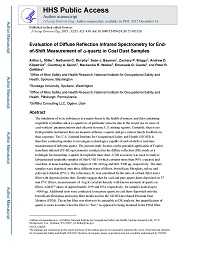Mining Publication: Evaluation of Diffuse Reflection Infrared Spectrometry for End-of-Shift Measurement of α-quartz in Coal Dust Samples
Original creation date: July 2015
The inhalation of toxic substances is a major threat to the health of miners, and dust containing respirable crystalline silica (α-quartz) is of particular concern, due to the recent rise in cases of coal workers’ pneumoconiosis and silicosis in some U.S. mining regions. Currently, there is no field-portable instrument that can measure airborne α-quartz and give miners timely feedback on their exposure. The U.S. National Institute for Occupational Safety and Health (NIOSH) is therefore conducting studies to investigate technologies capable of end-of-shift or real-time measurement of airborne quartz. The present study focuses on the potential application of Fourier transform infrared (FT-IR) spectrometry conducted in the diffuse reflection (DR) mode as a technique for measuring α-quartz in respirable mine dust. A DR accessory was used to analyze lab-generated respirable samples of Min-U-Sil 5 (which contains more than 90% α-quartz) and coal dust, at mass loadings in the ranges of 100–600 μg and 600–5300 μg, respectively. The dust samples were deposited onto three different types of filters, borosilicate fiberglass, nylon, and polyvinyl chloride (PVC). The reflectance, R, was calculated by the ratio of a blank filter and a filter with deposited mine dust. Results suggest that for coal and pure quartz dusts deposited on 37 mm PVC filters, measurements of −log R correlate linearly with known amounts of quartz on filters, with R2 values of approximately 0.99 and 0.94, respectively, for samples loaded up to ~4000 μg. Additional tests were conducted to measure quartz in coal dusts deposited onto the borosilicate fiberglass and nylon filter media used in the NIOSH-developed Personal Dust Monitor (PDM). The nylon filter was shown to be amenable to DR analysis, but quantification of quartz is more accurate when the filter is “free,” as opposed to being mounted in the PDM filter holder. The borosilicate fiberglass filters were shown to produce excessive interference, making quartz quantification impossible. It was concluded that, while the DR/FT-IR method is potentially useful for on-filter measurement of quartz in dust samples, the use of PVC filters produced the most accurate results.
Authors: AL Miller, NC Murphy, SC Bayman, ZP Briggs, AD Kilpatrick, CA Quinn, MR Wadas, E Cauda, PR Griffiths
Peer Reviewed Journal Article - July 2015
NIOSHTIC2 Number: 20045643
J Occup Environ Hyg 2015 Jul; 12(7):421-430
See Also
- Best Practices for Dust Control in Metal/Nonmetal Mining
- Determining the Spatial Variability of Personal Sampler Inlet Locations
- Direct-on-Filter alpha-Quartz Estimation in Respirable Coal Mine Dust using Transmission Fourier Transform Infrared Spectrometry and Partial Least Squares Regression
- Equivalency of a Personal Dust Monitor to the Current United States Coal Mine Respirable Dust Sampler
- Evaluating Portable Infrared Spectrometers for Measuring the Silica Content of Coal Dust
- Improving Silica Dust Control Through Targeted Research
- Laboratory and Field Performance of a Continuously Measuring Personal Respirable Dust Monitor
- NIOSH Hazard ID 1 - Exposure to Silica Dust on Continuous Mining Operations Using Flooded-Bed Scrubbers
- Respirable Size-Selective Sampler for End-of-Shift Quartz Measurement: Development and Performance
- A Review of Occupational Silica Exposures on Continuous Mining Operations
- Content source: National Institute for Occupational Safety and Health, Mining Program


 ShareCompartir
ShareCompartir
